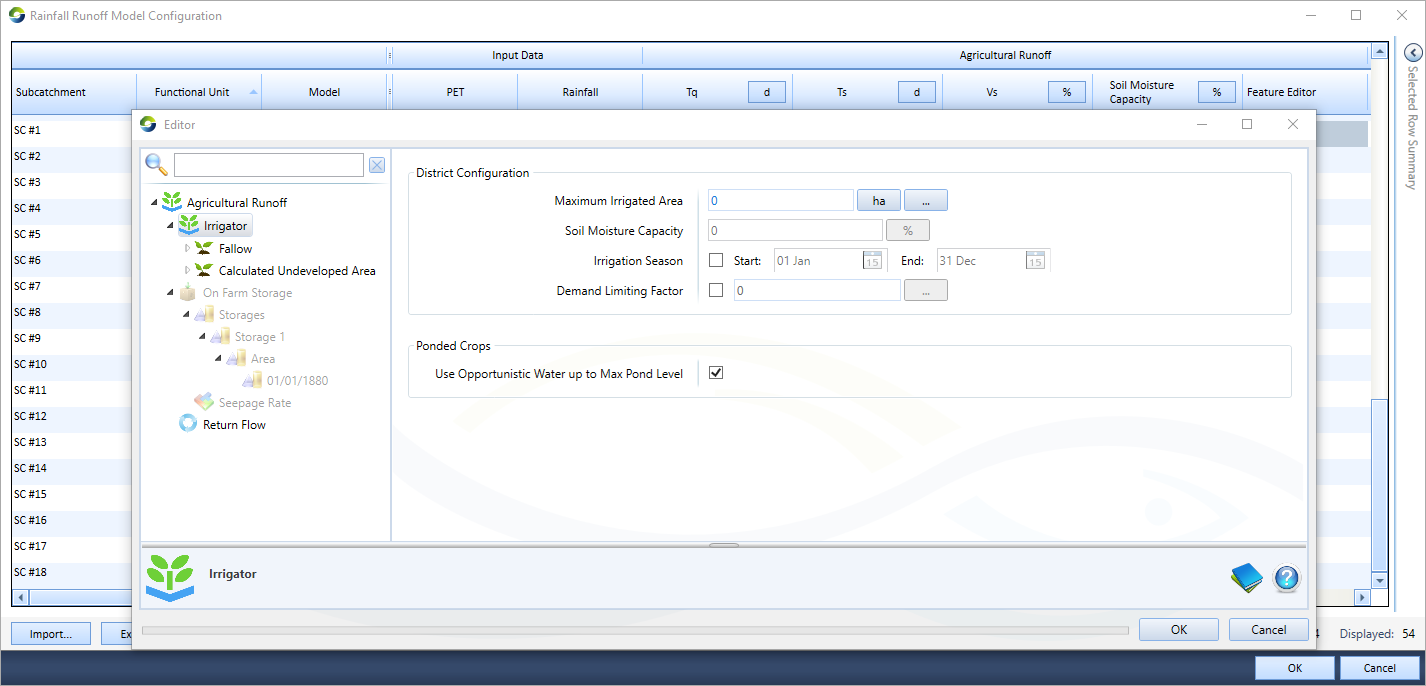Note: This is documentation for version 4.11 of Source. For a different version of Source, select the relevant space by using the Spaces menu in the toolbar above
Agricultural Runoff - SRG
The Agricultural Runoff rainfall-runoff model allows the user to implement the functionality of the Irrigator Demand Model as a rainfall-runoff model at the Functional Unit level. It is used to represent cropping areas in sub-catchments which are rain-fed and are not part of a command area which receives water from a dam (regulated irrigation). Crop water use and agricultural runoff are represented as part of the rainfall-runoff process. The daily crop water balance is based on the irrigator demand model and the method described in FAO56 (Allen et al, 1998). It models a daily crop water use, and generates runoff from rainfall excess from the functional units. The rainfall excess can be routed as quick flow and slow flow to the river system. Crop use of water from small storages in catchments can be represented by Water user node#farmstorages(OFS) (also known as check dams in some countries) within the agricultural runoff model.
The model contains one water balance parameter and three routing parameters.
Scale
The Agricultural Runoff rainfall-runoff model is a catchment scale model and operates at a daily time step.
Principal developer
The implementation of the Irrigator Demand Model as a rainfall-runoff model was undertaken by eWater Ltd.
Scientific Provenance
See Irrigator Demand Model - SRG
Version
Source version 4.2.1 and higher
Dependencies
None.
Availability
Automatically provided with Source.
Theory
The Agricultural Runoff Rainfall-Runoff model allows the user to implement the functionality of the Irrigator Demand Model as a rainfall-runoff model to represent rain fed cropping areas in sub-catchments. With some additions and exceptions, the same theory and assumptions underpinning the Irrigator Demand Model are also relevant to the rainfall-runoff model version. Beyond the parameters which are set up in the Rainfall-Runoff table, the Agricultural Rainfall-Runoff model is configured with the same options as those of the Irrigator Demand Model options. The Feature Editor column in the Rainfall-Runoff Model table is used to access and configure these.
Also available is the option to add flow routing to return flows, to represent the function of routing parameters in standard rainfall-runoff models. The Linear Storage Routing parameters Ts, Tq and Vs use the same algorithms as the Ts, Tq and SFI parameters described in the IHACRES-CMD - SRG, except that effective rainfall U is replaced with return flow at the point it leaves the water user.
There are four model parameters which are available for calibration and are set up in the main Rainfall Runoff (RR) Model table interface.
Agricultural Runoff Model parameters:
Parameter | Description | Units | Default | Typical Range |
Ts | Time constant governing the rate of recession of slow flow (Ts > Tq) | Time step | 10 | 1 - 100 |
Tq | Time constant governing the rate of recession of quick flow | Time step | 1 | 1 - 10 |
Vs | Proportion of slow flow to total flow | % | 50 | 0 - 100 |
| Soil Moisture Capacity | The difference in volumetric soil water content between field capacity and permanent wilting point | % | 0 | 10 - 30 |
Figure 1 Irrigator Demand Model interface
Additions
The relevant Functional Unit area should be equal to the maximum irrigated area plus any undeveloped area. The Undeveloped Area is then calculated internally by Source as the difference between the Functional Unit Area and the Maximum Irrigated Area.
The three routing parameters Ts, Tq and Vs in the Rainfall-Runoff table are only enabled if Enable Linear Storage Routing is toggled on.
Figure 2 Enable Linear Storage Routing
Exceptions
Soil moisture capacity is entered as a parameter in the Rainfall-Runoff Model table, and has been deactivated at the Irrigator Demand Model interface.
This model operates at teh Functional Unit/sub-catchment level and return flows are added to the sub-catchment outflow, not connected directly to the river network. Therefore Supply Points and return flow links are not relevant.
Features not available or relevant at the Functional Unit level include:
- ordering
- account sharing
- opportunistic water
- forecasting

